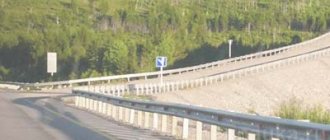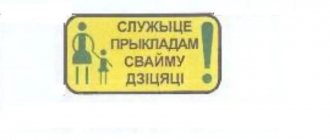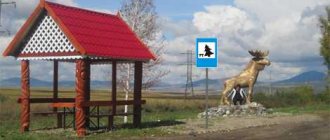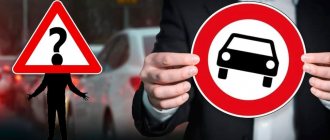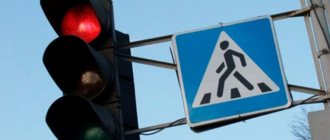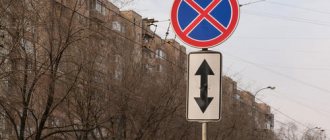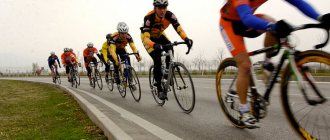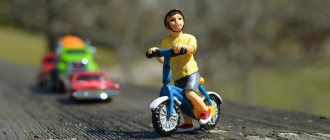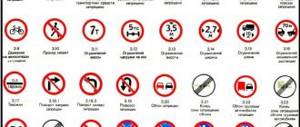Like a pedestrian, a cyclist is part of the road traffic. Everyone who uses a two-wheeled vehicle to move around the city must know the rules and road signs so as not to create emergency situations on the road. According to the traffic rules of Ukraine, a bicycle must be:
- equipped with reflective details. White are installed in front, yellow on the sides and red in the back.
- flashlight. When driving at night or in cloudy weather, a cyclist must turn on a flashlight (headlight). It ensures the cyclist's visibility on the road.
It is recommended to choose a flashlight with a red flashing function. This device produces brighter and more visible light.
Before leaving, be sure to check the serviceability of the bike’s brakes. If a mechanical failure is suspected, the driver should not use two-wheelers for travel, as this may cause an accident.
Cyclists are required to wear reflective clothing when riding on the road. At the same time, it should not hinder his movements while driving a bicycle. It is recommended not to choose clothes that are too loose or long, as they may get tangled in the spokes, pedals or chain. It is best to choose bright colors for clothing to be visible to surrounding drivers on the road. In specialized stores you can purchase a bright yellow vest, which is equipped with reflective stripes.
To protect yourself, you must wear a helmet while riding a bicycle. It will protect your head, the most important part of the body, in case of a fall. Injuring the head during a fall can cause brain damage! A helmet also protects the cyclist from sunstroke or rain.
To protect your hands, wear special cycling gloves. They will help reduce friction, prevent cracks and calluses from appearing on your hands, and protect you in case of a fall. It is also better to choose this accessory with reflective inserts in a bright shade. When cycling fast, dust and sand from the road can often get into your eyes. Wear cycling glasses that will cover your vision.
Basic rules of the road for cyclists
A cyclist on the road is a full participant in the road traffic. He must know the road signs for cyclists and their meaning. Any actions performed by cyclists on the road must be understandable to other road users. Also, they should not be done unexpectedly.
Requirements for a cyclist:
- Only those who have reached the age of 14 have the right to travel on the road.
- The vehicle must be in good working order and equipped with special reflective signs.
- A cyclist has the right to move only in a special lane for this type of transport. If it is missing, then in the far right lane of the roadway. It is also allowed to use the side of the road for movement.
The shoulder is considered to be a section of the road marked by a contour or continuous line of road markings, which is adjacent to the outer edge of the roadway. It is not intended for the movement of vehicles, except in certain cases provided for by traffic regulations. The shoulder can be used to stop vehicles, pedestrians, mopeds and bicycles if there is no sidewalk nearby.
- Leaving the far right lane is only allowed when passing pedestrians, potholes or parked cars.
- If a bicycle road intersects with a car road other than at an intersection, the cyclist must give way to other vehicles moving on the road.
- If a column of cyclists moves along the road, it should be divided into groups of up to 10 people. A distance of 80-100 meters should be maintained between each group. In a group, cyclists are required to ride one after another so as not to create difficulties for other road users.
- While driving on the roadway, a cyclist is required to give special warning signals before making a turn, stopping, making U-turns, etc. They look like this:
- Turning or changing lanes to the right—extend your right arm.
- Turning or changing lanes to the left—left arm extended.
- Stop - hand raised up.
It is also recommended to use a turn signal before passing vehicles parked on the edge of the road. The signal must be given in advance so that road users have time to recognize it and react. In a group of cyclists, the leader gives the signs first. The rest of the group must repeat the maneuver.
- A cyclist has the right to carry luggage that does not interfere with the passage of other vehicles and pedestrians.
3.Movement
Bicycles must move on a bicycle path (Traffic Regulations 24.3), and in its absence, on the roadway “only in one row, possibly to the right.”
"[2]. Driving on the side of the road is allowed if this does not interfere with pedestrians (Traffic Rules 24.2);
The movement of cyclists on sidewalks and pedestrian paths is prohibited (Traffic Rules 9.9).
Columns of cyclists when moving along the roadway must be divided into groups of 10 cyclists. To facilitate overtaking, the distance between groups should be 80-100 m. (Traffic Rules 24.2)
In the traffic rules of Belarus, driving on the roadway is prohibited. A cyclist may enter the roadway in exceptional cases when it is absolutely impossible to move beyond it. Riding a bicycle can be carried out on the sidewalk or pedestrian path without creating an obstacle to the safe movement of pedestrians (commentary to clause 148 of the Traffic Regulations of the Republic of Belarus).
A cyclist has no right:
- remove your feet from the pedals if you can’t hold the steering wheel;
- grab/hitch the bicycle to other vehicles;
- carry passengers on the frame;
- Children are allowed to be transported on a special seat that is securely attached to the bicycle stand. A child can be transported up to 7 years of age;
- move along the sidewalk and pedestrian zone (exception: children under 7 years old on children's bicycles);
- turn or turn to the left on tram tracks or a road with more than one lane. To make a left turn you need to: drive straight through the intersection, turn into the right lane of the intersecting road, and only at the traffic light signal drive straight again;
- get off the bike and cross the road at a pedestrian crossing, driving hand in hand;
Will my driver's license be revoked if I'm caught riding my bike drunk?
Many cyclists mistakenly believe that riding a bicycle does not carry any responsibility. Despite the fact that regulatory authorities pay minimal attention to cyclists, the law still provides for liability for driving while intoxicated. At the beginning of the article, we noted that a bicycle is a vehicle, and a cyclist is a driver.
The rules specifically prohibit driving any vehicle while intoxicated.
2.7. The driver is prohibited from:
- drive a vehicle while intoxicated (alcohol, drugs or other), under the influence of medications that impair reaction and attention, in a sick or tired state that jeopardizes traffic safety;
Can my driving license be revoked if I'm caught riding a bicycle while drunk? Let us turn to the article of the Code of Administrative Offenses of the Russian Federation according to which drunk drivers are punished:
1. Driving a vehicle by a driver who is intoxicated, if such actions do not constitute a criminal offense, -
shall entail the imposition of an administrative fine in the amount of thirty thousand rubles with deprivation of the right to drive vehicles for a period of one and a half to two years.
At first glance, it seems that the article is entirely suitable for cyclists and employees may try to attract attention based on it. However, riding a bicycle does not require a special driving license and obtaining, as well as deprivation of, such a right has nothing to do with driving a bicycle. For cyclists, the Code of Administrative Offenses of the Russian Federation provides a special article defining liability.
Please note that if you drive a scooter or moped while intoxicated, the application of this article is completely legal. The only exception for this article is cyclists.
Rules for crossing an intersection for cyclists
- All road users cross the intersection according to priority. A car moving on a secondary road must allow a cyclist on the main road to pass.
- When crossing an intersection that is not regulated, the vehicle that has no obstacle on the left has priority to cross the road (with the exception of a tram). A driver moving to the left must give way to a cyclist.
- At an unregulated intersection of bicycle paths with a road beyond the intersection, cyclists are required to clear the way for all vehicles traveling on the main road.
- Cyclists cross controlled intersections using bicycle traffic lights; if there are none, then using car traffic lights.
- A driver who turns right must give way to a cyclist who is moving next to him on the same road. A cyclist driving next to a car is required to give a sign indicating which direction he is traveling in order to warn turning motorists.
- When making a right turn, you must drive not next to the side of the road or curb, but closer to the middle of the right lane so that drivers do not try to maneuver, go around or overtake you. Then you will remain at a safe distance from cars.
Bicycle lane sign 4.4.1 in the 2019 traffic rules
A bicycle path is a section of road specially designated for the movement of cyclists with signs and markings. In the classical version, a bicycle is understood as a vehicle driven by human energy or a low-power electric motor.
The rules of the Road Traffic Regulations provide for the possibility of mopeds moving in a bicycle lane.
In exceptional cases, in the absence of a formal sidewalk, it is permissible for pedestrians to move along the lane allocated for cyclists; for this purpose, a series of signs from 4.5.2 to 4.5.7 are provided (visually pictures depicting these sign instructions can be viewed in the official publication of traffic rules). In this situation, the bicycle path is converted into a bicycle pedestrian path.
Iconic designations
Sign 4.4.1, which shows a bicycle on a blue background, marks the beginning of a bicycle path. It is installed to the right of the traffic lane or above it. Experienced motorists should pay attention to the changed numbering of the sign from 4.4 to 4.4.1.
Sign 4.4.2 corresponds to the end of the dedicated lane for bicycles and mopeds; it looks like sign 4.4.1 crossed out with a red line.
“Cycle path” sign 4.4.1 “End of cycle path area” sign 4.4.2
When a bicycle road crosses a carriageway, the indicated sign is duplicated in the event of further continuation of the bicycle path. In this situation, on the side of the roadway, signs “Intersection with a bicycle path” 1.24 are installed, calling on car drivers to be extremely careful. When passing through such an intersection, the cyclist is obliged to:
Nowadays, sidewalks are increasingly appearing along with the road for bicycles and are indicated by signs 4.5.2-4.5.7, and on some roads there are dedicated lanes for cyclists. Such sections of the road are indicated by signs 5.11.2, 5.13.3 and 5.13.4.
The “Bicycle in a red circle” sign indicates the impossibility of further travel on a bicycle. The citizen is advised to take a walking route or take a detour.
Sign 3.9 “No cycling”
Rule changes
The legislative activity of the state did not stop at specifying the basic concepts from the Traffic Rules. Innovations await all cyclists in general. Let us note the main transformations:
- Expanding the list of reasons allowing a cyclist to move on the right edge of the road (for example, due to the significant speed of 30 km/h for this type of equipment).
- In an uncontrolled intersection, a cyclist is required to give way to vehicles moving along the road being crossed or leaving residential areas and courtyard areas.
- The movement of cyclists outside the bike path should not interfere primarily with pedestrians.
Video: The concept of “bike path”
pddgarazh.ru
Crossing a pedestrian crossing by a cyclist
- When driving through a controlled pedestrian crossing, a cyclist must follow the signals of the bicycle or general traffic lights, as well as the traffic controller. If the crossing is not controlled, the cyclist must make way for pedestrians, just like all other vehicle drivers.
- Clearing the way for pedestrians heading to or from a tram stop, if one is located on the road, is a traffic rule.
- A cyclist must not cross the road in front of a pedestrian crossing or turn around at it. To perform this maneuver, the owner of a two-wheeled vehicle must get off the bicycle and cross the road like a pedestrian.
What is the maximum speed of a cyclist?
The maximum speed of a cyclist is limited to the same extent as for other vehicles. In the city it is prohibited to exceed the established limit of 60 km/h; in courtyards and residential areas the permitted speed is no more than 20 km/h. Cyclists are required to comply with speed limit road signs.
In addition, a cyclist can reach a speed above 25 km/h only using his own strength, since in accordance with the definition of “Bicycle”, the speed developed by a bicycle electric motor cannot exceed 25 km/h.
Traffic rules for cyclists in a group
- Cyclists traveling on the road in a group must ride one after another, forming a column. This is the only way they do not interfere with other traffic participants.
- Distance must be maintained between groups of cyclists.
- Everyone riding in a group must follow traffic signs given by the lead cyclist.
The leader of the group must know and be able to give the following signs:
- Turn left - left arm extended
- Turn right - right arm extended
- Stopping the whole group - hand raised up
- Left Pit Warning - Left Arm Angled
- Pit warning on the right - angled right hand
- The chief must also warn about pits out loud, saying “pit on the left” / “pit on the right.”
When overtaking on a flat section of the road, the cyclist must warn about the maneuver with the words “I’m going left/right.”
Cyclist behavior model
The cyclist is obliged to know and follow the requirements of the traffic rules (traffic rules), traffic lights, signs, markings and follow the commands of traffic controllers.
This means that drinking alcohol while driving and talking on the phone while driving is prohibited. It is not allowed for a cyclist to turn on solid lanes or ride oncoming on a highway with traffic in one direction.
Technical requirements
- It is the responsibility of cyclists to maintain their personal bicycle transport in a defect-free technical condition. A bicycle with a functioning brake and a working horn. There is no need to explain why reliable brakes are needed. A bell is especially needed when warning passers-by about the proximity of bicycles. When driving among cars, it is unlikely that the driver will hear the bell.
- Driving in the dark on the highway or in rainy, foggy, snowy weather, in other words, in conditions of incomplete visibility, is allowed only with a light. In front of a bicycle, a flashlight or a light reflector is required, behind - a flashlight and certainly a red reflector, but on the sides (closer to the front and rear dimensions) - amber-colored lights or reflectors, in addition, red rear side lights are allowed. It is absurd and risky to have a red reflector ahead; car drivers rarely notice cyclists, and here, in addition, a kind of confusion is created.
Rules for safe behavior on the roads
- The bicycle driver moves as close as possible to the right side of the track, exclusively in one row with other cyclists.
- When overtaking another cyclist or horse-drawn vehicle, and avoiding stopped traffic, you still need to move away from the right edge of the highway. It is more correct to drive as far as possible around an obstacle, for example, a stopped car, since the driver will immediately begin to get out of it, swinging the door open, or an unseemly person will throw the half-smoked cigarette out of the window.
- Remember that you can only overtake on the left if you don’t want to be pressed against the curb.
Best articles: Mudguards for different types of bicycles and tips for choosing them
It is also the responsibility of the bicycle driver to give a warning notice before performing any maneuver if there is no vehicle nearby.
Before each turn or lane change and before braking, the cyclist must be warned with a gesture, and immediately when turning the steering wheel or pressing the brakes.
You need to warn the rear rider in time, otherwise your late reaction will become dramatic.
Cyclist signals
Traffic regulations allow the following hand signals:
- The signal for a right turn or change of formation is the left arm extended in the direction of the turn, or the right arm directed away from the body and bent at the elbow at an angle of ninety degrees.
- The signal for a left turn or change of formation is the right arm extended in the direction of the turn, or the left arm directed away from the body and bent at the elbow at an angle of ninety degrees.
- The gesture of braking is raised upward and the right or left arm is straight at the elbow.
Gesturing with your palm does not acquire a privilege in movement, therefore, you always need to be sure that the rear moving driver of the vehicle understands the plans of the cyclist and will not overtake.
If there is a bike path near the route, cyclists are required to move exclusively there. This is indicated by a spherical indicator symbol with a white bicycle on a blue tone.
If the bicycle path is partially destroyed, covered with construction materials, or there are cars parked on it, then the bicycle driver can go around these obstacles along the road, he is not prohibited from doing so.
When traveling abreast, cyclists must ride in only one column along the route, in groups of 10 people. The distance between groups is from eighty to one hundred meters to simplify driving around.
When driving in a group, they use coordinated signals that are sent not to car drivers, but to other cyclists riding behind.
A bump or obstacle on the right side - the right hand points downwards.
A bump or obstacle on the left side - the left hand points downwards.
Initially, these signs are introduced by the head of the cycling group, and other riders are required to immediately reproduce them. You should not wait until you reach a bump or rock on the highway. It is necessary to immediately signal the threat to cyclists moving behind.
Help during a traffic accident
Helpline for cyclists (all over Ukraine): 097 900 9990
Number DAI— 102
Ambulance number—103
If a cyclist is involved in an accident, he must first assess his state of health: are there any injuries that could be life-threatening. If any, you must immediately call an ambulance. Only after this call the traffic police and the cyclist assistance service. Pedestrians who witness an accident involving a cyclist should help him. What a pedestrian can do:
- Call an ambulance, DAI and Motohelp. Tell them the location where the accident occurred, the details of the accident and the number of participants.
- Inspect the scene of the accident to ensure that the victims are not in danger from other vehicles or the risk of fire.
- Protect the scene of an accident using a special triangle, which should be in the trunk of drivers. At night you must use a flashlight.
- Ensure the safety of those involved in the accident, especially if they are injured or unconscious.
The cyclist must provide first aid to the participant in the accident if he is able to stand up:
- stop the bleeding
- perform a cardiac massage if necessary to restore the heart rhythm
- perform artificial respiration procedure
- fix the fracture, if any;
- move the victim to a safe place
provide psychological assistance to the victim:
- monitor the emotional state of a person;
- speak in a calm and confident voice;
- do not allow the victim to look at the injuries, if any;
- reassure, downplay the complexity of injuries
collect information about the accident:
- take photographs or videos from the scene of the incident;
- write down vehicle numbers;
- take telephone numbers from witnesses;
- save the victim’s insurance policy information;
- ask for video footage from surveillance cameras of nearby stores/offices;
What will be the violation?
To make it easier to imagine the size of fines, keep in mind that the basic amount as of 01/01/2019 in Belarus is 25.50 rubles (approximately 12 US dollars).
Responsibility10 for violating traffic rules will overtake you in the following forms:
- Violation in a sober state and without victims - a warning or a fine from 1 to 3 basic units.
- If you violated the rules while under the influence of alcohol or drugs - a fine of 3 to 5 basic units. The same fine may be imposed for refusing to undergo a test for intoxication.
- If the violation led to the creation of an emergency situation - a fine of 3 to 8 basic units, and if it caused minor bodily injury or damage to property - a fine of 5 to 25 basic units. The same amount of fine faces the person who left the scene of an accident in which he became a participant.
Best articles: Reviews of ardis bicycles
From practice, we can say that admitting guilt helps to obtain the minimum fine, although in each specific case the decision is made individually.
A collision between a cyclist and a pedestrian is not considered a traffic accident, and in this case, if necessary, you should call the police, not the traffic police.
In Belarus, there is a law that confiscates cars from drivers who are caught driving while intoxicated two or more times. Fortunately, this does not apply to bicycles, and they cannot take a bicycle away from a drunken cyclist, even if they catch him in this state several times. But this is not a reason to drive drunk!
Do not violate traffic rules, drive your bike carefully, respect yourself and others. Not to avoid fines, but to make the city a comfortable and safe environment for everyone.
The next post is even more interesting: How to ride among pedestrians.
Stay with us - Urbanoid on Telegram, VK, , Instagram and Strava!
How to take photos from the scene of an accident
- take photos of the accident from all angles;
- take a photo of the accident diagram;
- Take all photos at right angles. Only the braking path is from above;
- Next to each object, place a small object to compare sizes (ruler, pack of matches, pen, etc.).
How to communicate with witnesses:
- Explain to witnesses that they are not at risk from testifying;
- Write down your contact information;
- Record the testimony of witnesses.
Safety rules when riding a bicycle on the roadway
- Don't talk on your cell phone while riding your bike, especially on the road.
- do not listen to music while driving on the roadway
- Install a special rear-view mirror on the steering wheel or helmet. It will allow you to control the situation on the road.
- Before making a turn, U-turn or stopping, make sure that no driver is trying to pass you on the right or left side. It is recommended to look around 100 meters before the turn and immediately before it.
- try to avoid tunnels and bridges during rush hour. Use the sidewalk to avoid crowding during heavy traffic.
- When riding in a tunnel, be sure to turn on all the lights on your bike.
- When stopping at a red light at an intersection, try to drive slightly ahead of all the cars. This way you ensure that you are visible to all drivers.
- Always be aware of the traffic in the next row of cars. Drivers do not always have time to react to traffic lights or simply decide to ignore them.
- If you see an obstacle ahead (a hole, debris, an animal, etc.), do not try to maneuver at speed. It is best to slow down and smoothly drive around the object. Sudden movement may cause a fall or collision.
- Hold the steering wheel firmly when driving over uneven terrain, puddles, sand or potholes. If you lose control, you risk colliding.
- Learn the rules of the road for motorists if you plan to ride a bicycle on the road.
Cyclist safety
Not everyone understands that a bicycle is equal to a car, so on the road a cyclist will need to follow the general rules of movement on the roadway (regarding non-motorized vehicles).
Let's look at what important factors need to be taken into account for the safe movement of cyclists.
Serviceability
Namely, check all the most important parts of the bicycle (handlebars, working brakes), check whether it is equipped with other important parts for driving on the highway:
- reflectors (back, front, and sides);
- flashlights that work at night;
- a working bell to sound a signal.
A cyclist must highlight his bicycle on the roadway so that both the vehicle and the driver himself are clearly visible to all other road users.
Road signs
- priority signs;
- signs of special instructions (informing about the movement of route vehicles, one-way traffic);
- signs that indicate the direction of movement;
- signs prohibiting turns and entry.
However, the cyclist must also know all other signs and strictly observe them. While driving, the bicycle driver should also take into account road markings:
- It is forbidden to cross a solid line;
- do not stand in places that are marked in yellow;
- allow pedestrians to cross the zebra crossing.
Also, the cyclist must move correctly in a group, be extremely attentive and have good reactions.
Speed
But on the road you should develop and maintain a fairly high speed, at least 20 km/h.
Sticking to this speed limit is necessary because driving too slowly can interfere with cars, as they will have to maneuver around the cyclist.
This is especially true on narrower roads, where passing oncoming and passing traffic is difficult.
It is worth noting that high speed is only justified if all other vehicles are moving quickly.
Distance
Side spacing is the distance across the width. Safe and comfortable riding on the road requires maintaining a distance and interval so that if a dangerous situation develops, the cyclist can turn to the side.
If the distance with the car in front decreases, you will need to slow down, or vice versa - speed up if the distance decreases with the vehicle behind.
In case of parallel movement, you should not press too close to parked or passing cars, and there are good reasons for this:
- There is a chance of falling on the car as a result of an uneven road.
- The car may hit the cyclist in some way.
- The door of a stationary car may suddenly open.
So, attentiveness is the key to safe cycling. In this case, you should carefully monitor what is happening on the sides and in front.
The road is movement, so the situation can change every second. It is useful to purchase a special rear-view mirror and attach it to the steering wheel, thanks to which you can also monitor the road from behind.
Road signs for cyclists
- “Cycle path or lane for cyclists” This sign marks the beginning of a special section of the road for cyclists.
- “The end of a cycle path or lane for cyclists.” Indicates the cessation of a special section of road for cyclists
- “Pedestrian and bicycle path with combined traffic
This means that not only cyclists, but also pedestrians can move on this section of the road
- “The end of the pedestrian and bicycle path with combined traffic. This means that the combined section of the road for pedestrians and cyclists ends.
- "Pedestrian and bicycle path with traffic separation"
Indicates that the sidewalk is divided into two parts: for cyclists and pedestrians. They are distinguished constructively or indicated by markings.
Fines for cyclists
Article 12.29. Violation of the Traffic Rules by a pedestrian or other person participating in traffic
2. Violation of the Traffic Rules by a person driving a bicycle, or a driver or other person directly involved in the process of road traffic (except for the persons specified in part 1 of this article, as well as the driver of the vehicle) - eight hundred rubles
.
3. Violation of traffic rules by persons specified in part 2 of this article, committed while intoxicated, shall entail the imposition of an administrative fine in the amount of one thousand to one thousand five hundred rubles.
.
Violations of the traffic rules discussed in this article for a cyclist will cost 800 rubles, and in case of committing a violation while intoxicated, from 1000 to 1500 rubles.
The growing trend towards a healthy lifestyle is forcing car drivers to switch to a two-wheeled vehicle - a bicycle. An increase in the number of this type of transport leads to the creation or allocation of part of the highway for bicycle paths. However, to prevent their four-wheeled counterparts from crowding out their two-wheeled counterparts, there is a bicycle lane sign in front of the lane for the latter to move. Mopeds and scooters are also allowed to move along it.
A bicycle path is considered to be an independent road or part of a highway dedicated to the traffic of bicycles, scooters and mopeds. Cars, horse-drawn vehicles and pedestrians are prohibited from entering the designated lane. The latter can walk along it if there is no sidewalk, curb or pedestrian areas.
The bicycle street sign is presented in the shape of a blue circle with a white bicycle image. This road attribute belongs to the category.
International traffic agreements define a bicycle lane as a separate road or part of it dedicated to cyclists. Such zones are indicated by an appropriate road sign and are structurally separated from the roadway.
Such areas are separated from the roadway by a dividing strip, a piece of land with grass, side stones or slabs. Many European cities can boast of similar lanes, which form an entire transport network. Russian regions provide only isolated areas for two-wheeled riders, not to mention the lack of a transport network.
The presence of a bicycle lane indicates that cyclists should only ride on it. Driving onto the roadway is considered by traffic rules to be a violation of traffic regulations.
Organizing the traffic of rover-cyclists comes down to several methods.
Two-wheeled vehicles move:
- along a dedicated lane on the sidewalk;
- a separate road that is adjacent to the sidewalk or roadway;
- a designated area, isolated by natural objects and side stones.
The latter zone may be located on a road with one-way traffic on both sides. A two-way highway has the right to place only one lane on the surface for rovers, on the side where the width of the road allows. Often such sites are located on the side of the primary location of local administrative institutions, shops, and public utility facilities.
Paths for two-wheeled vehicles come in various types. There are one-way roads that border the highway on both sides. The countries of Northern Europe have a similar entire network, where the bicycle route is somewhat raised above the level of the roadway. American cyclists use single-level trails, however, they are separated from road surfaces by a parking or buffer strip.
Two-way traffic is usually found on a lane along a street or road surface. Large cities cannot allocate enough space for the mentioned riders; more often the ribbons are located in the suburbs and towns.
Joint traffic of pedestrians and bikers cannot be ruled out:
- If a highway has several secondary street connections on one side. The lanes are located on the opposite side, which ensures safety for cyclists from cars entering the highway.
- Along the streets, where on one side there are local administrative bodies, shops, and medical institutions. Cyclists will not have to cross the street many times in the right direction.
- The best arrangement of lanes would be a highway with a one-way flow, where you can border it on both sides and organize the movement of bicycles along the street. However, they may be endangered by vehicles coming out of courtyards or adjacent streets, whose drivers will not expect the appearance of two-wheelers.
- A two-way bicycle path isolated from the highway is an excellent alternative to the ones described above. Of course, it can be called a full-fledged road, even with a sidewalk adjacent to it. But even if it does not exist, the lane is used for shared passage by pedestrians and rovers.
Typically, such lanes are located away from streets with heavy traffic, with sidewalk platforms passing nearby, which does not prevent either pedestrians or drivers of two-wheeled vehicles from moving in both directions.
Special paths are either adjacent to the roadway or are arranged separately. The first case is the streets of cities with heavy traffic, the other is areas between areas of large settlements, tourist routes.
The advantages of such arrangements are:
- separation from pedestrians and vehicles;
- ease of movement;
- the possibility of a leisurely trip, especially for older people.
However, there is no positive without negative.
This is also observed here:
- coverage width no more than 1 meter;
- it is difficult to overtake the vehicle in front;
- difficulties arise when traveling;
- low speed compared to driving on a highway.
Of course, the last disadvantage can be easily overcome, once you get on the road. But if there are road signs with a bicycle path, leaving the roadway is prohibited. The long length of the lane still smoothes out the speed barrier, but after driving a couple of hundred meters along it, you have to drive the bike to the next specialized section.
A well-designed bike path has a high-quality surface, located slightly above the roadway level. In front of the described zone there are road signs for cyclists and special markings separating oncoming traffic. The stencil is indicated by a white bicycle with opposing stripes on a blue circle.
Paths with combined pedestrian and bicycle traffic are common in Scandinavian countries. Of course, it’s impossible to call them specifically bicycle areas; these are not areas isolated from people walking.
The rules and GOSTs of the Russian Federation are adapting to the innovation, which should be reflected in the near future by the appearance of such infrastructure - combined tapes with traffic separation for participants in the traffic process. Quite wide sidewalk passages with little rover traffic are suitable for this.
These attributes should make life easier for cyclists; they will not have to get under the wheels of speeding cars. This may be a step forward, but even these sections suggest the advantage of a person on their feet rather than in the saddle of a bike. The desire of the latter will be to break out into the operational space of the highway.
Bicycle trails are good on tourist routes that run in:
- sea or river embankments;
- streets prohibited for cars;
- wide sidewalks;
- city parks;
- narrow streets, bridges, crossings.
Such places allow drivers of two-wheeled vehicles to avoid high-speed transport, take an evening walk, and get some fresh air.
Of course, such conditions will not suit everyone; there are some disadvantages:
- scurrying pedestrians;
- lack of proper speed when traveling;
- often narrow ribbons;
- Difficulty when passing an oncoming bicycle.
And people walking often associate such roads with a pedestrian sidewalk, not taking into account that a bicycle is the same transport, albeit a slow one. The blue circle with the designation is more likely to be taken as a decoration of the road than as a warning attribute. It’s nice to walk through such an area, and not have to turn your head to avoid getting hit by a wheel.
A blue circle with a bicycle logo is installed:
- On the right side of the bicycle section or belt, which is separated from the road surface by side stones or a grass lawn.
- The “Traffic Lane” sign is installed above the bicycle lane, showing the traffic lane covered by the sign or traffic light.
The initial form is established before the start of the bicycle lane, and the repeated form is established after each junction of the secondary road with the bicycle section.
The form with a stencil obliges drivers of cars, other motor vehicles and pedestrians not to enter the special lane. The sign's coverage area ends at the nearest intersection, the intersection of a secondary street. The absence of a repeated established form indicates the end of the separate section for two-wheeled vehicles.
The action of the street sign is also limited by another form - a similar blue circle with a red stripe diagonally. He warns against further movement on a bicycle while in the saddle. The biker should leave the saddle and roll the two-wheeled vehicle by the handlebars.
The presence of a clear bicycle path, but without the installation of a mandatory sign, gives the right to be on it simultaneously to cyclists and drivers of motor vehicles.
Megacities set aside specially equipped zones and road sections for two-wheelers. The latter are indicated by special stencils in the form of a black silhouette of a bicycle on a white base or a separate traffic light eye. Its illuminated windows with a similar image indicate permissive movement to the rover.
On the roadway, cyclists are treated as full participants in the process, which imposes certain obligations on them.
This is manifested in their giving of signals about the upcoming maneuver:
- The turn to the side is preceded by bending the raised corresponding arm at the elbow.
- A stop is preceded by any hand raised vertically.
Of course, traffic regulations also provide for the rover's advantage over cars when it is on its own path.
However, he should pay special attention to areas near the junction of secondary streets:
- The presence of a sign in the shape of a blue circle gives the right to move forward if there is no danger of the car in front turning to the right.
- The presence of a white triangular shape with a red border - “Intersection with a bicycle path” indicates the passage of a car, but not a bicycle.
The absence of any special signage does not affect bicycle traffic.
They have the right to take:
- roadside, moving in a column or transporting large cargo on the rear trunk;
- pedestrian area if there is a child under 7 years old.
Independent movement of adolescents under 14 years of age is permitted only in specially designated areas. The speed of movement of two-wheeled vehicles in local areas, as well as cars, should not exceed 20 km/h, in city limits - 60.
Road signs for pedestrians and cyclists
- "End of pedestrian and cycle path with traffic separation." This means that the divided section of road for pedestrians and cyclists ends.
- "Footpath". The sign indicates that traffic is permitted for pedestrians and cyclists in accordance with the rules of the road.
- "Road with a lane for cyclists." Indicates the beginning of the road along which the movement of cyclists and moped drivers is carried out along a specially designated lane towards the general flow of vehicles.
- "The end of the road with a lane for cyclists." The road sign indicates that there is no lane for cyclists further on the roadway.
- “Entering a road with a lane for cyclists.” Indicates that further down the road a special lane for cyclists begins.
- Lane for cyclists" This sign is valid only on the lane in front of which it is placed. It means that a lane begins on the road reserved only for cyclists. The effect of signs installed on the right of the road extends to the right lane.
- "The end of the lane for cyclists"
The effect of signs installed on the right of the road extends to the right lane. Indicates that the lane designated specifically for cyclists no longer continues.
- "Artificial Roughness" The sign lets you know about irregularities on the road. Install it at the nearest boundary of the artificial bump relative to approaching vehicles.
- "Living sector". This sign is installed before the start of a residential zone, in which drivers of all vehicles are required to reduce speed.
- "Pedestrian zone". The sign marks the beginning of a road intended for pedestrians only. A cyclist has no right to travel on this road.
- "Motorway". Indicates an exit to a motorway. Cyclists are required to follow the rules of the road for this type of road.
- "Crosswalk". This sign warns that there is a pedestrian crossing area ahead. The sign is installed to the right of the road relative to the approaching vehicle.
- "No entry". Prohibits the entry of all vehicles in this direction. The sign does not apply to route vehicles.
- "Movement Prohibition". All vehicles are prohibited. Does not apply to route vehicles, special vehicles for transporting disabled people and government transport.
- "Bicycles are prohibited." The movement of bicycles and mopeds on a certain section of the road is prohibited.
Traffic rules for cyclists in 2021
Almost every one of us, at least once in our lives, has ridden a bicycle. A cyclist, like any other road user, is obliged to know and comply with the requirements of the Road Traffic Rules. At the height of the warm season, when the number of cyclists on the roads increases sharply, it is useful to remember the requirements imposed by the Rules on cyclists. And today our topic is traffic rules for cyclists.
First, let's look at the definition of “Bicycle”, in accordance with the Road Traffic Rules.
“Bicycle” is a vehicle, other than a wheelchair, which has at least two wheels and is generally propelled by the muscular energy of the occupants of the vehicle, in particular by means of pedals or handles, and may also have an electric motor of rated maximum power in continuous load mode not exceeding 0.25 kW, automatically switches off at speeds over 25 km/h.
The most important thing to take away from this definition is that a bicycle is a vehicle. Accordingly, all requirements of the Road Traffic Rules relating to vehicles also apply to bicycles.
Let's look at the following important definitions.
“Cyclist” is a person driving a bicycle.
“Driver” is a person driving a vehicle, a driver leading pack animals, riding animals or a herd along the road. A driving instructor is treated like a driver.
It should be noted here that the person driving a bicycle is not only a cyclist, but also a driver of a vehicle.
Traffic regulations for cyclists.
Let's begin our review of the requirements imposed by the Rules on cyclists with the second section of the traffic rules, failure to comply with which may affect traffic safety.
2.3. The driver of the vehicle is obliged to:
2.3.1. Before leaving, check and ensure that the vehicle is in good technical condition on the way in accordance with the Basic Provisions for the admission of vehicles to operation and the responsibilities of officials to ensure road safety (hereinafter referred to as the Basic Provisions).
It is prohibited to drive if there is a malfunction of the service brake system, steering, coupling device (as part of a road train), unlit (missing) headlights and tail lights in the dark or in conditions of insufficient visibility, or if the windshield wiper is not working on the driver’s side during rain or snowfall.
If other faults arise along the way, for which the appendix to the Basic Provisions prohibits the operation of vehicles, the driver must eliminate them, and if this is not possible, then he can proceed to the place of parking or repair, taking the necessary precautions.
Considering that a bicycle is a vehicle, therefore the driver (cyclist) is obliged to check the technical condition of his bicycle before leaving. If the steering, braking system is faulty or the headlights and tail lights are not lit (missing), riding a bicycle in the dark or in conditions of poor visibility is prohibited by the Rules!
Let's consider the main points of the section of traffic rules for cyclists that are directly related to the rules of movement of cyclists.
24.1. Cyclists over 14 years of age must use bicycle paths, bicycle pedestrian paths, or bicycle lanes.
Clause 24.1 requires cyclists over 14 years of age to move first: on bicycle paths, bicycle pedestrian paths or a lane for cyclists.
Traffic regulations for cyclists. In the picture, a bicycle path marked with sign 4.4.1 “Bicycle path”.
Unfortunately, today you cannot find a bicycle path or lane for cyclists everywhere. In this case, paragraph 24.2 of the Rules provides the conditions under which cyclists are allowed to move along the right edge of the roadway, shoulder, sidewalk or pedestrian path. Here it is necessary to note that the conditions for the movement of cyclists given in paragraph 24.2 are mutually exclusive.
It is allowed to move along the right edge of the roadway only if there is no bicycle and pedestrian path or lane for cyclists.
24.2. Cyclists over 14 years of age are allowed to ride on the right edge of the roadway - in the following cases:
there are no bicycle and bicycle pedestrian paths, a lane for cyclists, or there is no opportunity to move along them;
the overall width of the bicycle, its trailer or the cargo being transported exceeds 1 m;
cyclists move in columns;
Traffic regulations for cyclists. In the picture we see that the bike path and lane for cyclists are missing. The cyclist, in accordance with the requirements of paragraph 24.2 of the Rules, moves along the right edge of the roadway.
Please note that the Traffic Rules require a cyclist to move along the right edge of the roadway, namely in the same direction as other vehicles. This is understandable; traffic in Russia is on the right. Unfortunately, it is very common to see cyclists on the roads driving towards vehicles.
Traffic regulations for cyclists. A cyclist is in violation of traffic rules, moving towards the movement of vehicles.
The movement of cyclists on the side of the road is permitted only in the absence of the conditions specified above.
on the side of the road - if there are no bicycle and bicycle pedestrian paths, a lane for cyclists, or there is no opportunity to move along them or along the right edge of the roadway;
Traffic regulations for cyclists. In the photo, cyclists are moving along the side of the road. In this case, driving on the right edge of the roadway outside the city may be unsafe.
The rules also allow cyclists over 14 years of age to ride on a sidewalk or pedestrian path, but only under the conditions specified below.
on the sidewalk or pedestrian path - in the following cases:
there are no bicycle and bicycle pedestrian paths, a lane for cyclists, or there is no opportunity to move along them, as well as along the right edge of the roadway or shoulder;
the cyclist accompanies a cyclist under the age of 14 years or transports a child under the age of 7 years on an additional seat, in a bicycle stroller or in a trailer intended for use with a bicycle.
Traffic regulations for cyclists. The rules allow a cyclist under the age of 14 to be accompanied on the sidewalk.
The next paragraph of the Traffic Rules for cyclists obliges young cyclists aged 7 to 14 years to move only on sidewalks, pedestrian, bicycle and bicycle paths, as well as within pedestrian zones.
24.3. The movement of cyclists aged 7 to 14 years should be carried out only on sidewalks, pedestrian, bicycle and pedestrian paths, as well as within pedestrian zones.
Traffic regulations for cyclists. In the photo, a child (a cyclist under 14 years old) is on the roadway. Despite the fact that the little cyclist is under the supervision of a parent, this is a violation of traffic rules.
Cyclists under the age of 7 years can only move in the territories specified in paragraph 24.4 of the Rules.
24.4. Cyclists under 7 years of age should only ride on sidewalks, pedestrian and bicycle paths (on the pedestrian side), as well as within pedestrian zones.
Traffic regulations for cyclists. In the photo, a small cyclist is moving along the sidewalk, as required by the Traffic Rules.
When driving on the roadway, cyclists should not forget about the requirements of the following paragraph of the Rules.
24.5. When cyclists move along the right edge of the roadway in the cases provided for by these Rules, cyclists must move only in one row.
A column of cyclists may move in two rows if the overall width of the bicycles does not exceed 0.75 m.
The column of cyclists must be divided into groups of 10 cyclists in the case of single-lane traffic, or into groups of 10 pairs in the case of double-lane traffic. To facilitate overtaking, the distance between groups should be 80 - 100 m.
Traffic regulations for cyclists. Cyclists when driving on the roadway must move in one row.
The next paragraph of the rules obliges cyclists to dismount if they interfere with the movement of other persons.
24.6. If the movement of a cyclist on a sidewalk, pedestrian path, shoulder or within pedestrian zones endangers or interferes with the movement of other persons, the cyclist must dismount and follow the requirements provided for by these Rules for the movement of pedestrians.
Traffic regulations for cyclists. When driving on the sidewalk, if pedestrians are obstructed, the cyclist must dismount.
Now let's turn to paragraph 24.8 of the Rules, which states what is prohibited for cyclists.
24.8. Cyclists and moped drivers are prohibited from:
drive a bicycle or moped without holding the handlebars with at least one hand;
transport cargo that protrudes beyond the dimensions by more than 0.5 m in length or width, or cargo that interferes with control;
transport passengers if this is not provided for by the design of the vehicle;
transport children under 7 years of age in the absence of specially equipped places for them;
turn left or turn around on roads with tram traffic and on roads with more than one lane for traffic in a given direction;
drive on the road without a fastened motorcycle helmet (for moped drivers);
cross the road at pedestrian crossings.
Traffic regulations for cyclists. Cyclists are prohibited from riding a bicycle without holding the handlebars with at least one hand.
One of the most common violations of traffic rules by cyclists is driving on pedestrian crossings.
Traffic regulations for cyclists. In the photo, cyclists are crossing a pedestrian crossing, thereby violating the Traffic Rules.
In the next image, the child, unlike many adult road users (cyclists), knows how to correctly apply the Rules!
Clause 24.9 of the Rules prohibits the towing of bicycles; clause 24.10 recommends that cyclists carry objects with reflective elements at night.
24.9. Towing of bicycles and mopeds, as well as towing with bicycles and mopeds, is prohibited, except for towing a trailer intended for use with a bicycle or moped.
24.10. When driving at night or in conditions of insufficient visibility, cyclists and moped drivers are recommended to carry items with reflective elements and ensure that these items are visible to drivers of other vehicles.
Regardless of whether we are drivers, pedestrians or cyclists, we are obliged to comply with the requirements of the Rules of the Road.
1.3. Road users are required to know and comply with the relevant requirements of the Rules, traffic lights, signs and markings, as well as comply with the orders of traffic controllers acting within the limits of the rights granted to them and regulating traffic with established signals.
At the end of the review of traffic rules for cyclists. Only we can decide what example to set for children... the choice is ours.
Example 1. Violation of traffic rules by cyclists.
Example 2. Driving through a crossing in accordance with the Traffic Rules.
If you have questions on the topic “Traffic rules for cyclists in 2020”, write in the comments or in the VKontakte group - SCHOOL-TRAFFIC RULES.
To all cyclists, good weather and safe roads!
